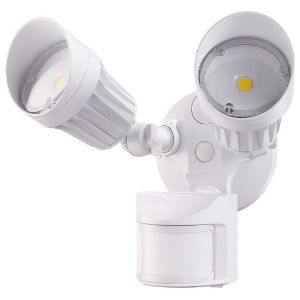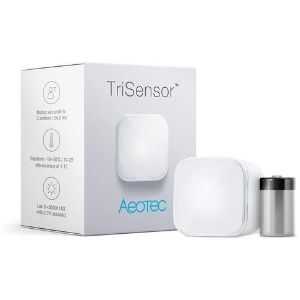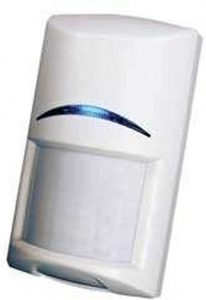The Beginner’s Guide to Motion Sensors
A motion sensor (or motion detector) is the linchpin of your security system because it detects when someone is in your home when they shouldn’t be. A motion sensor uses one or multiple technologies to detect movement in an area.
When a sensor detects motion, it sends a signal to your security system’s control panel, which connects to your monitoring center. This alerts you and the monitoring center to a potential threat in your home.
Answers to your questions about motion sensors
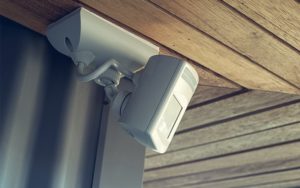
The role of motion sensors in home security
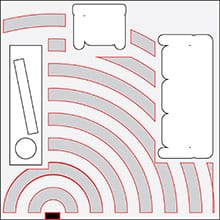
The main purpose of motion detection is to sense an intruder and send an alert to your control panel, which alerts your monitoring center.
Sensors work when you're not home or when you tell the system you are not there. You can even program some security systems to record events via a security camera when there's motion.
Motion sensors stand guard, ready to react to various situations, such as movement in your living room, windows or doors opening or closing, or a window breaking.
Here are some common uses of motion sensors:
- Alert you in the event that your teen breaks curfew
- Trigger a doorbell when someone approaches the front door
- Alert you when kids enter restricted areas in the home, like the basement, workout room, or medicine cabinet
- Save energy by using motion sensor lighting in unoccupied spaces
- Notify you if pets enter areas where they’re not supposed to be
Types of motion sensors
Passive infrared (PIR)
Passive infrared sensors detect body heat (infrared energy) by looking for changes in temperatures. They are the most-widely-used motion sensor in home security systems. When you arm your system, this activates the motion sensors to report possible threats.
Once the sensor warms up, it can detect heat and movement in the surrounding areas, creating a protective “grid.” If a moving object blocks too many grid zones and the infrared energy levels change rapidly, the sensors trigger an alarm.
Microwave (MW)
This type of sensor sends out microwave pulses and measures the reflections off of moving objects.1 They cover a larger area than infrared sensors but are more expensive and vulnerable to electrical interference.
Dual technology motion sensors
Some motion sensors can combine multiple detection methods in an attempt to reduce false alarms. For example, it's not uncommon for a dual technology sensor to combine a passive infrared (PIR) sensor with a microwave sensor.
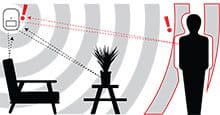
Each sensor type operates in different areas of the spectrum (ranging from passive to active). Dual technology motion sensors are not as likely as other types to cause false alarms, because both sensors need to trip in order to sound an alarm. However, this does not mean that they never cause false alarms.
Less common types of motion detectors
Amazon.com price as of 6/10/2021 at 10:30 a.m. (MT). Read full disclaimer.
- Area reflective sensors emit infrared rays from an LED and use the reflection of those rays to measure the distance to the person or object, allowing for detection when the subject moves within the designated area.
- Ultrasonic motion sensors measure the reflections off of moving objects via pulses of ultrasonic waves.
- Vibration motion sensors detect small vibrations that people cause when they move through a room. While you can buy them, they're easy to make at home too. A homemade vibration sensor uses a small mass on a lever, which activates an alarm switch when it vibrates. Homemade motion sensors can work, but they can also be unreliable.
Specialized motion sensors
Contact sensors (door/window)
Contact sensors use a magnet to spot movement on a door or window. When the sensor and corresponding magnet move apart as a door or window opens, the sensor triggers an alarm while the security system is armed.
Pet-immune motion sensors
Most passive infrared sensors can ignore animals up to a certain weight. A dual technology motion sensor is more pet resistant to false alarms because it requires two sensors to be triggered a certain way.
Some pet-immune motion sensors have an adjustable sensitivity level for homes with energetic pets.
Video motion sensors
Many security cameras use advanced signal processing2 to start recording when they sense motion. Cameras controlled by motion sensors can save on memory storage by not recording hundreds of hours of useless footage—they only capture the important stuff.
Best practices for mounting sensors
Subscribe to our YouTube channel for more helpful home security tips.
Today, most motion sensors are wireless. Wireless sensors are very easy to set up. They do not require drilling, and they communicate with the other security system components wirelessly.
Amazon.com price as of 6/10/2021 at 10:30 a.m. (MT). Read full disclaimer.
With wireless motion sensors becoming standard, DIYers have it easier than ever when it comes to installation. If you know how to use a screwdriver, you can install a motion sensor. Correct installation gives you optimal coverage for motion detection and helps avoid false alarms.
If you choose a security system that requires professional installation, the installer will know how to set up your sensors. However, you are responsible for setting up your sensors if you go with a DIY home security system.
Before you install motion sensors, make sure to read the installation instructions, since they will likely include placement recommendations. Some DIY systems also give you electronic prompts, video tutorials, or have you call a representative to walk you through the setup process.
Keep in mind that motion sensors aren’t error-proof, and there are instances in which there could be false alarms. False alarms are usually caused by electrical failures, user error, poor application engineering, power surges, lightning, and faulty equipment. Animals, insects, and foliage can also trigger them under the right circumstances.
Placement tips
While the best thing you can do to increase the effectiveness of your sensors and prevent false alarms is to read the instructions that come with them, here are some placement tips to help leverage the sensor's strengths:
1. Keep PIR sensors 10–15 feet away from heat sources like radiators, heating vents, and sunny windows.3 Motion sensors can trip upon detecting a swift change in heat, even that of a cloud passing quickly over direct sunlight in your living room.
2. Place motion sensors at “choke-points”—areas where people have to walk through, like the stairwell or main hallway. That way, an intruder trips the sensor regardless of destination.
Intruders usually go right for the master bedroom, so put a sensor near that room or other rooms with valuables, like the study.
3. Assess where intruders are most likely to enter and what path they would take. Most burglars enter the home through a front or back door, patio door, or garage door, so it’s advisable to place the sensors near those areas.
4. Find walls that an intruder would walk alongside, like a hallway or narrow pathway that leads to a room. Motion sensors work best when the intruder walks parallel to the sensor, not toward it.
For example, in a hallway you tend to walk parallel to the walls, not directly toward them.
How to install a motion sensor
Amazon.com price as of 6/10/2021 at 10:30 a.m. (MT). Read full disclaimer.
With wireless motion sensors becoming standard, DIYers have it easier than ever when it comes to installation. If you know how to use a screwdriver, you can install a motion sensor. Correct installation gives you optimal coverage for motion detection and helps avoid false alarms.
1. Unbox your motion detector
Your motion sensor kit should come with some instructions and mounting hardware. If your device has separate batteries, now’s the time to put them in your motion sensor.
2. Decide on a location
You should consider the most effective sensor placement before mounting your motion detector:
- Corners are an ideal location, because you can position infrared sensors to cover the most area. Most motion sensor designs have angled edges with screw holes so they fit nicely into the corner of a room.
- Mount your motion detector high on the wall to get the best coverage—but avoid putting it over a large piece of furniture, like a bookshelf or entertainment center, because it will limit the passive infrared energy range.
- Mount your motion sensor opposite a main entrance—this applies in every room or hallway where you place these sensors so they can detect intruders right away.
3. Mount the sensor
Passive infrared sensors are lightweight, so you won't have to worry about drywall anchors or studs. A standard screwdriver should do the trick, but an electric screwdriver or drill can speed up the process.
Most motion detectors have a mounting bracket that pops off the main body of the device so you can screw it into the wall first, then clip the motion sensor back in. This also makes it easier for taking the motion detector off the wall during maintenance. Other infrared sensors may require a full disassembly for mounting.
4. Connect your sensor to your system
Amazon.com price as of 6/10/2021 at 10:30 a.m. (MT). Read full disclaimer.
Follow the manufacturer's instructions to connect your motion sensor to your system. Most DIY systems walk you through this process, often using the main keypad or mobile app to set up and adjust your motion detectors.
If you have smart motion detectors, like the Z-Wave powered Aeotec TriSensor (about $45), you can connect it to lights and other smart devices through a smart hub like SmartThings so that a light turns on whenever there's motion. You can even use the smart hub's app to schedule motion alerts to your mobile devices when there's movement is during certain times of the day or night.
5. Adjust your motion detection settings
Most motion detectors have three main settings when you arm your system:
- In instant mode, all motion triggers an alarm.
- In entry delay mode, the sensor operates on a delay—even if it detects motion, you have roughly 30–60 seconds to disarm the system before an alarm.
- Interior follow-up mode works on an entry delay, but only when door contact triggers first—though it sounds an instant alarm if it detects motion in the home without a door contact triggering.
6. Maintain your motion detector
Over time, dust and debris can gather on the screen of your motion sensor and interfere with the infrared energy, making it less effective at motion detection. Clean it at least once every couple of months with a dry or slightly damp microfiber cloth.
If you decide to paint a wall near your motion sensor, be sure to remove the device first. If you get any paint on a passive infrared motion sensor, you need to replace it.
Additional tips for installing motion sensors
Amazon.com price as of 6/10/2021 at 10:30 a.m. (MT). Read full disclaimer.
Consider the size of your pets
Pet-immune motion sensors are only immune to pets when you use them correctly, and even then they can create false alarms under certain conditions.
Many pet immune sensors use ratings related to an animal's weight, but even small pets can trigger them with enough verticality. If your pet likes to practice their high jump, it can set off false alarms.
This is especially important if you have active sensors near a stairwell. At the bottom of the stairs, the sensor treats your pet like a mouse, but by the time your pet reaches the top, the sensor might see an elephant.
Overhangs decrease range
When installing LED motion sensor lights or cameras outside, keep in mind that installing them under an overhang (like a carport) can reduce their range.
Just like your field of vision decreases when you're wearing a hat with a brim or a visor, an overhang can block the motion detector light's 180-degree sensing angle, turning it into a 90-degree sensing angle.
Don’t block the infrared
Motion sensors are like flashlights sending out a beam of light but with motion-detecting infrared energy waves instead of light waves. Just like a light is brighter closer to the bulb, the infrared radiation is denser nearer to the device and it spreads out farther away.
A motion detector's waves can't penetrate through walls or other hard objects like furniture. When you set up your motion sensor, imagine it like a light on the wall. Anything that creates a shadow from that light's position can also block the motion sensor's ability to cover the shadowed area.
Motion sensing light switches aren’t all equal
When choosing motion sensing light switches for indoor use, remember that not all motion detection switches work the same.
- An occupancy sensor turns on automatically when you enter a room and off again when you leave.
- A vacancy sensor turns off the lights when a room is empty, but you have to turn it on.
- Dimmer sensors are customizable for turning on lights at different levels of brightness.
Brands like Lutron have motion sensor light switches that come in all three options so you can choose the one that's right for you.
Other uses for motion sensors
Motion sensors aren’t just for home security. Many industrial fields use them on assembly lines to keep track of the number of products and to shut down dangerous equipment if a person gets too close.
Here are a few other uses for motion sensors
- To open and close automatic doors
- To turn on and off automatic water faucets and toilets
- To turn on lights when a person enters a room
- To control ATM displays
- At automatic ticket gates
- For some parking meters
Final word
Motion sensors aren’t just an additional feature of a security system—they are essential. Without sensors, there wouldn’t be a way to detect intruders.
Hopefully our guide taught you the motion sensor’s role in your home’s security, the various technologies employed in motion detection, and how to properly install your sensors so they can do their job. For help researching your home security options, check out our article on the best home security systems.
By signing up, you agree to our Terms and Conditions and Privacy Policy.
Related articles on SafeWise
Sources
- Tom Harris, HowStuffWorks, "How Burglar Alarms Work," February 2002. Accessed June 10, 2021.
- Tim O'Leary, Security Info Watch, "Making Sense of Motion Sensors," October 2008. Accessed June 10, 2021.
- Digikey, "Panasonic Electric Works Design Manual," January 2005. Accessed June 10, 2021.
Disclaimers
*Amazon.com list price as of 6/10/2021 at 10:30 a.m. (MT). Product prices and availability are accurate as of the date/time indicated and are subject to change. Any price and availability information displayed on Amazon at the time of purchase will apply to the purchase of this product. Safewise.com utilizes paid Amazon links.
Certain content that appears on this site comes from Amazon. This content is provided “as is” and is subject to change or removal at any time.
The post The Beginner’s Guide to Motion Sensors appeared first on SafeWise.
Article source here: The Beginner’s Guide to Motion Sensors


